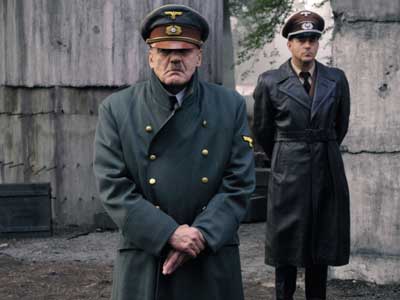Downfall - and the mystery of Karajan's personal photographer
 Bruno Ganz in the cinema as Hitler.
Bruno Ganz in the cinema as Hitler.Following on from The Chorus we went to see Downfall last week. Director Oliver Hirschbieger has made a stunning film, but the accolades must go to Bruno Ganz's extraordinarily powerful performance as Hitler. In my book his performance is up there alongside Dirk Bogarde's Aschenbach in Visconti's Death in Venice for immersing himself so totally, and so convincingly, in the role. Yes, I understand the reservations about the film 'humanising' the Nazi leaders, and the 'white-washing' of the role of Hitler's secretary Traudl Junge, on whose memoir the film is partly based. But just as Shakespeare's plays provide a valid 'drama-documentary' view of English history, so equally Downfall gives us a dramatised (and arguably sanitised) view of the last days of Hitler. The film lasts for more than two and a half hours (and thankfully uses music very sparingly, there is no Wagner of Bruckner at all, despite the fact that the slow movement of the Seventh Symphony was played on Berlin Radio after the announcement of Hitler's death). I have never seen an audience (of all ages) so engrossed throughout a film, or more silent at the end. We need documentary facts, but we also need dramatisations to bring history to life.
Downfall reminded me of one of life's little mysteries. When I was writing my recent post My first classical record I started researching Siegfried Lauterwasser, the 'official' photographer to the conductor Herbert von Karajan - an example of his work is seen below. I worked at EMI in the 1970s when Karajan was one of our artists and I was fascinated by the 'court' that surrounded him and was intrigued by their background. It is documented that Karajan joined the Nazi Party on April 8th 1933 in Salzburg, two months after Hitler came to power. He was cleared by an Austrian Governement denazification tribunal in February 1946 which concluded that Karajan was not involved in any illegal activity between 1933 and 1938. A transcript of the tribunal is given in Richard Osborne's Karajan - A Life in Music (Chatto & Windus ISBN 1956197638, the following exchange is taken from that transcript:
Dr Zellweker, Deputy Chairman of Tribunal: 'Surely you must have had some thoughts about (politics), and then there you were in 1935 joining the Party.'
Karajan: I'm prepared to admit that it was an error, but we artists live in another world, a self-contained one. Otherwise it would be impossible to play music properly, and music is the highest and only thing for me.' 
A Google search on Siegfried Lautterwasser returns a web site at the George Eastman House, International Museum of Photography and Film. It appears this archive is part of Ryerson University in Toronto. It contains the Siegfried Lauterwasser Collection of photos. These are all available online, and they are quite an eye opener. Open the links for coverage of Martin Borman's Visit to Unteruhldingen - May 4-6, 1935 (Boorman was Hitler's number two, and a racist who was outstanding among some finely developed examples of the species), the Nuremberg Rally - September 1935, and much more. The photos have a captivating, haunting and chilling quality. Forget their repugnant subjects, these are compelling images.
Hitler in real life, as captured in the Siegried Lauterwasser Collection
But here is the mystery. Who actually took these photos? They are on the web site as the Siegfried Lauterwasser Collection, and the Lautterwasser in question must be the same one as Karajan's photographer as his dates are identical. There are 'Research and attribution' notes on the site, but these are as clear as mud about the origin of the photos, and talk vaguely of 'an unknown Nazi photographer'. So presumably Lautterwasser didn't take them. If not, why are they labelled as his collection? What is the link between him and the photos? The mystery deepens as a key link on the 'Research and attribution' notes is broken. I've sent several emails to both Ryerson University and George Eastman House about the collection, and have not yet received a reply. (For an update on this post, and for confirmation that the pictures are indeed the work of Lauterwasser see my post The mystery of the Siegfried Lauterwasser Collection solved via the internet - Pliable 19/04/2005).
So what is the link (if any) between Siegried Lauterwasser and these extraordinary photos? Or is the whole thing an elaborate (and bad taste) hoax? Anyone who can shed any light on this fascinating mystery plesae post the explanation using the comments icon below.
Update -For confirmation that the pictures are indeed the work of Lauterwasser see my post The mystery of the Siegfried Lauterwasser Collection solved via the internet - Pliable 19/04/2005).
Further update - just as some other sites have picked up on this post the server hosting the photo archive in Canada at George Eastman House/Ryerson University has started intermittent performance/connectivity problems (nice to think its the traffic we've generated!). If you aren't getting the images on my post, or can't link across to the Siegfied Lauterwasser Collection site please keep trying, it is well worth it when you finally connect - Pliable 27/04/2005)
29th April - a further update with fascinating information on the discovery and attribution of the Lauterwasser archive – see How photo archive was salvaged from a trash can 
Another image from the mysterious Siegfried Lauterwasser Collection
Any copyrighted material on these pages is included as "fair use", for the purpose of study, review or critical analysis only, and will be removed at the request of copyright owner(s). Report broken links, missing images and errors to - overgrownpath at hotmail dot co dot uk








Comments